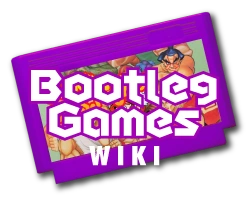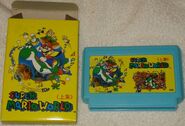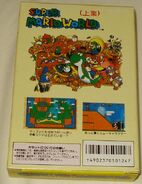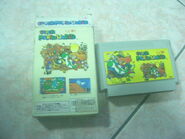Super Mario World is a bootleg port of the SNES [1] launch title of the same name, developed by Hummer Team and released in 1995. This is one of the more well-known examples of bootleg ports to the Famicom, as it comparatively manages to retain most of the elements that defined the SNES original without sacrificing too much quality.
Overview
The SNES-to-NES conversion manages to retain many elements of the original, including the fire and cape powerups, the map screen, and even Yoshi. Many of the more subtle details were also ported successfully, such as a more powerful spin jump and throwing items upwards.
2 player mode is also present, with player 2 controlling Luigi on the same controller as player 1. Strangely, Luigi always begins at the first level no matter where Mario starts. Both brothers start with 15 lives, and can earn more by visiting Yoshi houses or finding 1-up Mushrooms in courses.
Gameplay mechanics are similar to the SNES version. The physics for Mario are similar to those of Somari in that if he jumps from full speed he will suddenly slow down to a walking pace, which makes him somewhat awkward to control; in addition, slope physics are possibly reversed, in that Mario picks up speed while going up a slope but is drastically slower to run downwards. Yoshi is the same as in the SNES version, being able to eat enemies and spit them out, and the cape powerup allows Mario to fly by running until his arms spread out, jumping, then pressing left-right in an alternating rhythm, just like in the original.
The game can glitch up if there's too many sprites on the screen, which might be why the Banzai Bills were replaced with three horizontal Podoboos. As well as this, various levels are omitted, most notably the Switch Palaces.
The music and graphics are mostly from the SNES version, downgraded to 8-bit. The game has fewer and lower-quality music tracks, and there are also slight palette issues similar to that of other Hummer Team games.
Differences from the SNES game
- Mario's Super/Fire/Cape sprites are an amalgamation of his Super Mario World body and Super Mario Bros. 3 head, even though Mario is Missing! and Mario's Time Machine using Mario and Luigi sprites that are closer to the real SMW. Small Mario is a reproduction of the SNES version.
- Multiple Yoshi houses are present across the map, compared to only one in the original. Mario/Luigi also gains an extra life by entering/exiting them in the port.
- Switch Palaces, bonus areas, and secret exits are not present. The obscure 3-up moon in the first level has its ledge intact, but there is no reward for flying up there.
- Map design is different and more linear, seen in Yoshi's Island and Forest of Illusion (these areas allow multiple paths in the SNES game).
- Most of the level designs do not match up with the SNES version for technical reasons. For example, an area in Morton's Castle is all new because of the port lacks vertical scrolling that the SNES version has.
- Only the overworld map is present; interior areas from the original game, like Vanilla Dome and Valley of Bowser, are not present, or their levels are moved out into the overworld. Star World and Special World are not present at all.
- The Valley of Bowser levels are placed on islands on the main world map,. The Bowser cave in the NES version serves as the final level.
- Music is rearranged; the title theme plays during "athletic" levels, the Forest of Illusion map theme plays during forest levels, and the Vanilla Dome map theme plays on the Chocolate Island section of the map. The Valley of Bowser theme plays when selecting the last two levels, and is also oddly used as the Starman theme.
- No bonus or point system for finishing the course or touching the goal ribbon.
- Due to fewer buttons on NES, spin jump is activated with Up+Jump. It cannot be used to bounce off of normally-indestructible enemies like Piranha Plants and Boos, unlike the original. However, it can defeat most enemies in a single jump, including Dry Bones, which were indestructible in the original.
- Turn Blocks and ? Blocks do not function properly; they do not have unique sprites for being "used", nor do Turn Blocks spin when Mario hits them. Unused turning sprites for the Turn Blocks exist, and can be seen in the incomplete version's unused levels, but they were not implemented in the game properly.
- Mario cannot destroy any blocks, making it impossible to enter certain bonus areas (like the first level).
- Pipes do not transport Mario anywhere, instead just acting like platforms. The exceptions in the finished version are the cannon pipes, which are not available in the unfinished version, and certain pipes within regular levels, which all transport Mario to the 1-up game (hitting 3 ? blocks in the correct order to gain 1-ups).
- Mario cannot bang on climbable fences.
- Cape Mario lacks unique sprites for diving/gliding while flying. Cape Mario also cannot slow down falls using the cape.
- Iggy Koopa, Ludwig Von Koopa and Larry Koopa were removed from this port most likely because the lack of Mode 7 in the NES. The former two's castles remain in this port, but Reznor replaces the Koopalings.
- Music does not change for boss battles, and they lack the unique tilting platform mechanic that some SNES bosses used (due to hardware limitations).
- Mario cannot swim in water in non-underwater levels, similar to Super Mario Bros. 1. Falling into one is the same as falling into a bottomless pit.
- Lava will not cause instant death on contact. Instead, it damages Mario, then the rest of the lava is treated as a bottomless pit.
Versions
- Incomplete ("Volume 1"): if Super Mario World is found on a single cart, it's the unfinished version. It only goes up to the fourth castle, and the level select is only activated by pressing Select, Select, Select, Select, Select, B, B while on the map (although you have to press Select again to reach it). While the other levels are present, they are mostly broken and/or unfinished.
- Complete: the one described in the article, known to be found on a 45-in-1 multicart. For some reason, level select is automatically activated once the start button is pushed.
Trivia

Yoshi's Island 3

Donut Plains 1
- There are unused tiles of Lakitu, Spiny, Fishbone, Bullet Bill, Muncher, Clapping Chargin' Chuck and Digging Chargin' Chuck.
- Notably, Nintendo once stated that although they had wanted to give Mario a dinosaur companion since Super Mario Bros. 1, but that this was isn't possible with the limited hardware of the NES.[1] However, Hummer Team were able to do so in this port.
- The JY Company logo Easter egg is accessible by pressing Up, Right, A, Down, Right, B, Up, Left while paused. The logo is garbled in the incomplete version.
- Entering YUSUPLAZ (complete version) or YUXLALAZ (incomplete version) into a Game Genie will fix the jumping physics of the game, so that Mario does not lose speed after a jump. [2]
- Some of the graphics used in the game, such as Mario looking up, are unused graphics from Super Mario Bros. 3.
- In the incomplete version, the JY Company logo can be found in the backgrounds of Yoshi's Island 3 and Donut Plains 1.
Connections to other Hummer Team games
- A couple of the game's tracks are present, unused in the ROM of Donkey Kong Country 4, also by Hummer Team.
- Kart Fighter uses graphics from SMW.
- Harry's Legend uses sounds from SMW, notably the jumping sound which is the same as getting onto a Yoshi in SMW.




